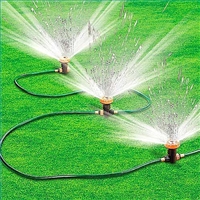
 Keeping your lawn thick, green, and healthy means doing several things right. One of the most important is making sure there’s enough moisture to maintain growth. Nature’s rainfall schedule is not dependable. Some additional watering is almost always necessary, at least during our hot, dry summers.
Keeping your lawn thick, green, and healthy means doing several things right. One of the most important is making sure there’s enough moisture to maintain growth. Nature’s rainfall schedule is not dependable. Some additional watering is almost always necessary, at least during our hot, dry summers.
Lawns turn brown, thin out, and just don’t look good when under water stress. A thin, water-stressed lawn also creates room for weeds to invade. So whether you use underground or portable sprinklers, there are a few basic guidelines to follow to avoid these problems and maintain good lawn health.
Irrigate deep, but infrequently!
Too many people with sprinkler systems water every day for short duration. Frequent, but shallow watering causes the grass to send roots to the surface for water, where they suffer more during dry, hot spells. Water for longer duration and when you water, saturate the soil to a depth of 6″ to 8″. This may mean leaving your sprinklers on for 30 minutes or more per cycle, depending upon your water pressure and volume.
If you water deeply, you can usually get by on irrigation once every 3-4 days. It varies according to the season, grass type, and soil type. During spring rainy periods, supplemental irrigation may not be needed. During summer, you may need to water every day, especially in a sandy soil or if we experience extreme droughts such as we did last year.
As a general rule, your turf needs about 1.5″ of moisture per week in order to perform well, whether supplied from natural rainfall or supplemental irrigation.
Time of day makes a difference
Early morning is the best time to water your lawn, before the heat of the day. This will insure that more of the water goes down into the soil rather than being lost to evaporation. Avoid watering in the evening, especially on Fescue turf, which is more susceptible to turf disease during warm, humid weather.
